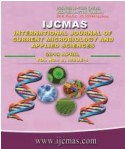


 National Academy of Agricultural Sciences (NAAS)
National Academy of Agricultural Sciences (NAAS)

|
PRINT ISSN : 2319-7692
Online ISSN : 2319-7706 Issues : 12 per year Publisher : Excellent Publishers Email : editorijcmas@gmail.com / submit@ijcmas.com Editor-in-chief: Dr.M.Prakash Index Copernicus ICV 2018: 95.39 NAAS RATING 2020: 5.38 |
A field experiment was conducted during winter 2016-17 and 2017-18 at Agronomy research farm, Jobner, Rajasthan to evaluate the weed growth, nutrient removal, weed control efficiency, yield and nutrient uptake by wheat [Triticum aestivum (L.) emend Fiori & Paol] as influenced by nitrogen levels (0, 45, 90 and 135 kg/ha) and weed control methods (weedy check, once HW at 25 DAS, two HW at 25 & 45 DAS, 2,4-D ester @ 0.5 kg/ha, metsulfuron methyl @ 4 g/ha, sulfosulfuron 75%+ metsulfuron methyl 5 WG @ 40 g/ha and mesosulfuron 3%+ iodosulfuron 0.6% @ 14.4 g/ha). Two hand weeding (HW) at 25 and 45 (DAS) had the significantly lowest weed biomass (151.5 kg/ha), weed control efficiency (90.03%), N, P and K depletion (2.91, 0.45 and 2.47 kg/ha), highest grain (4.65 t/ha), straw yield 5.72 t/ha and N, P and K uptake (113.7, 28.6 and 113.9 kg/ha) followed by mesosulfuron 3%+ iodosulfuron 0.6% @ 14.4 g/ha (PoE) (Pooled data two years). Nitrogen fertilization at 90 kg/ha significantly improved the weed biomass, weed control efficiency, nutrient depletion, grain yield, straw yield and nutrient uptake by wheat crop over the preceding levels. However, it remained statistically at par with 135 kg N/ha.
 |
 |
 |
 |
 |